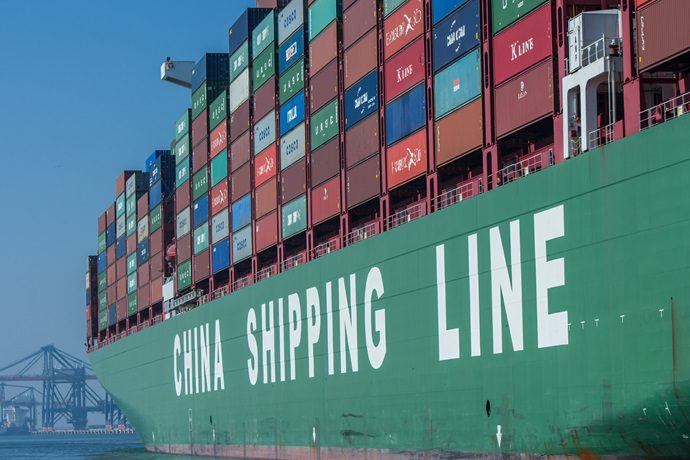04.11.2025
Poland’s and the EU’s trade with China
Poland has maintained a relatively stable level of exports to the Chinese market for many years. Between 2020 and 2024, the value of sales of our goods to China oscillated around USD 3-3.6 billion per year. Although a decline to USD 3.15 billion was recorded in 2022, only two years later Polish exports increased to USD 3.58 billion, returning to pre-pandemic levels and global economic turmoil.

Poland – like the entire European Union – largely bases its market on Chinese industrial and consumer goods.
Polish exports to China
The structure of Polish exports shows that our trade with the Middle Kingdom is driven by raw materials and machinery.
Non-ferrous metals have remained in first place for years – primarily copper, which is the foundation of Chinese industry and technology. In 2024, its exports reached USD 626 million, which is more than one-sixth of all Polish exports to China.
In second place are electrical machinery, apparatus and equipment, which in 2024 brought Poland USD 396 million in revenue. This is a very broad category – from specialized industrial components to electronic equipment. At the same time, it is an area where strong competition from China itself is visible.
In third place come power generation machinery (USD 340 million), which is in line with Chinese investments in the modernization of its energy sector.
Other important items include road vehicles (USD 184 million) and scientific and control equipment (USD 130 million) as proof that Poland is able to offer high-quality products in selected sectors.
Despite these successes, Polish exports to China are still limited – structurally focused on a few sectors and small compared to the value of imports.
Polish imports from China – dominance of electronics and industry
The Polish market is hugely powered by Chinese electronics and machinery.
The largest category is electrical machinery, apparatus and equipment – in 2024, imports in this group reached as much as USD 9.4 billion. This is more than 2.5 times more than all Polish exports to China. This category includes, among other things, household appliances, electrical components or machinery used in industry.
The second largest category is telecommunications equipment and equipment for recording and reproducing sound, with a value of USD 7.8 billion. These are smartphones, tablets, laptops and accessories – products that hit the shelves of Polish stores and for the everyday use of millions of consumers.
In the following places were:
- office machines and automatic data processing equipment (USD 4.6 billion),
- clothing and apparel accessories ($4.1 billion),
- miscellaneous products not elsewhere listed (USD 3.9 billion).
The balance sheet is showing a growing disproportion
Moderate exports and dynamically growing imports show the scale of challenges in trade with China. In 2024. Poland sold goods worth USD 3.58 billion, while it imported goods from China for USD 54.5 billion. The difference, or trade deficit, was about $51 billion. Such an unfavourable balance for Poland also proves the enormous potential of the Chinese market for domestic exporters. If we manage to gradually expand our offer – not only with raw materials, but also with high-quality technological and consumer products – Poland can make greater use in the future of the opportunities offered by cooperation with one of the world’s largest market.
EU-China trade – facts and figures
Together, the European Union and China account for almost 30% of global trade and more than a third of global GDP.
In 2024 alone, the value of trade in goods and services between the two sides reached more than EUR 845 billion.
China remains the EU’s largest trading partner, and the EU itself is China’s third largest partner.
EU trade in goods with China – deficit and momentum
In 2024, EU exports to China amounted to EUR 213.2 billion, while imports reached as much as EUR 519 billion.
Compared to 2023, both exports and imports decreased slightly (by 4.6% and 0.3%, respectively). Over the past decade, imports from China to the EU have increased by over 102 percent, and EU exports to China – by almost 47 percent.
European markets are mainly supplied with telecommunications and audio equipment, computers and office equipment, as well as broadly understood electrical machines.
The European goods that do best in China are industrial machinery, automobiles and motor vehicles, and parts for them.
Exchange of services from the Eu with China
Trade in services is also becoming increasingly important. In 2024, its value exceeded EUR 112 billion. The EU exported €67.3 billion worth of services to China and imported €45.5 billion. As a result, the EU has a surplus in trade in services with China of around €21.7 billion.
The largest role was played by transport, specialist and scientific services, as well as IT and telecommunications services. Fees for the use of intellectual property have also been an important pillar of EU exports.
Investments with the automotive sector at the forefront
Mutual investments show how deeply the European and Chinese economies intertwine. In 2023, EU investment in China amounted to almost EUR 232 billion, and in 2024 new investment reached EUR 10.1 billion.
At the same time, the presence of Chinese capital in Europe is also growing. By 2023, investments from China reached nearly EUR 65 billion, and in 2024 there were as much as EUR 9.4 billion of new funds. The greatest involvement of the Middle Kingdom concerns the automotive, entertainment, education and media industries, as well as consumer products.
Sources:
- Council of the EU (Consilium) “EU-China trade: facts and figures”
- The Central Statistical Office (GUS)
Translated by IDC
JL
Spis treściTable of contents
- Introduction
- Polish exports to China
- Polish imports from China – dominance of electronics and industry
- The balance sheet is showing a growing disproportion
- EU-China trade – facts and figures
- EU trade in goods with China – deficit and momentum
- Exchange of services from the Eu with China
- Investments with the automotive sector at the forefront